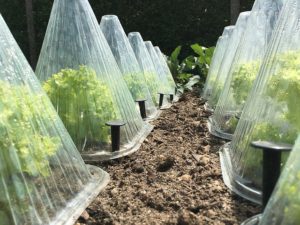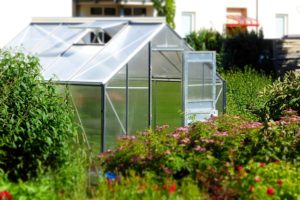 Frost warnings usually send shivers down the backs of gardeners. A good frost can kill plants outside in a wink of an eye and they occur in the fall and the spring.
Frost warnings usually send shivers down the backs of gardeners. A good frost can kill plants outside in a wink of an eye and they occur in the fall and the spring.
Find out when frost is most likely to occur in your area with a Frost Dates Calculator found on the internet.
This will give you a good idea of when to worry. Your local news station will most likely broadcast frost warnings too, so watch your 10 or 11 PM news.
It is vital that plants be protected from frost or they will die. Temperatures below 32 degrees are devastating to plants and even 40-degree temperatures can damage tender plants.
What Is Frost?

Frost is most likely to occur on clear, cold evenings. During summer, dew collects on leaves of plants at night and the same thing happens when it gets cold except the water does not evaporate. Instead, it crystalizes on the leaves and becomes frost because of the air temperature.
Different plants react differently to frost. Tropical plants do not survive frost and should be planted in pots in cold climates and brought inside when temperatures start falling.
Annuals are tender and do not withstand heavy frosts. Many perennials will survive, but their foliage will be killed by a freeze.
They will come back once it gets warm again. Shrubs usually survive a freeze, but they will go dormant only to burst forth with leaves in spring. Evergreens stop growing and their sap is reduced.
Effects Of Frost On Plants!

The effects of frost on plants varies as to the type of frost and the type of plant. There are several types of frost:
Hard Frost, or Killing Frost is the type that leaves white crystals on the roof and all over the leaves of the plants. It is when temperatures go below 30 degrees for many hours.
Plants will brown and sometimes turn black. Annuals, perennials, vegetables, herbs, shrubs and trees are all affected.
Moderate Frost is when dew or fog freezes but not quite into crystals. It looks as if plants have an icy glaze on them. Ice forms inside the plant flowers and leaves and cells burst.
Most plants are killed by this type of frost too but shrubs and trees are more likely to survive Black Frost is when a true frost did not form but it got cold enough to damage leaves of plants. Leaves often turn black with this type of frost.
Light Frost only goes below freezing for a few hours and harms only tender plants, annuals and houseplants. Some annuals and most perennials may survive a light frost.
All types of frosts are deadly to plants.
That doesn’t mean your plants will die if there is a frost. You have to be on the ball to protect them so they can live on to grow from spring to summer or grow a little longer in the fall.
Protect Ideas!
One of the most common things used protect plants from frost is a big bedsheet.
 Cover them before the frost comes in at night. Weigh down the sheet with bricks or rocks so it can’t be blown off by wind and make sure it isn’t too heavy tol flatten your plants underneath.
Cover them before the frost comes in at night. Weigh down the sheet with bricks or rocks so it can’t be blown off by wind and make sure it isn’t too heavy tol flatten your plants underneath.
It is a good idea to build a rim around parts of the garden with wood and chicken wire for the sheet to rest on.
The covering must touch the ground to provide maximum protection.
Other items you can use in a similar way is newspapers and bedspreads. Do not use plastic sheets as they do not protect as well as those made of fabric.
- Use a bucket, glass jar or big flower pot to cover individual plants.
- Cover plants with evergreen branches or straw, but this is more permanent and better for end of the year protection. Mulch (wood mulch) can be used. Coverings must be pulled back away from the roots of the plant during the day.
 Keep gallon jugs in your shed or garage and fill them with water. Put them all around your plants if a frost is forecast. The warm water will keep the plants warm.
Keep gallon jugs in your shed or garage and fill them with water. Put them all around your plants if a frost is forecast. The warm water will keep the plants warm.- Row covers are available at home and garden stores. They look like a simple box or long, curved boxes that sit over top of rows in the garden.
- Always remove any protection or coverings before the sun gets hot the next day. It will harm plants if they are left on.
Garden Design!
It is possible to design a garden that is less susceptible to frost damage. Here are a few ways to do that:
Plant your garden so that it slopes toward the morning sun. The heat warms the soil and is retained causing cold air to flow away.
- Plant the garden in a clearing of trees. When trees surround the garden, they act like a blanket.
- Surround your garden with a stone wall. The stone soaks up the sun’s rays and keeps the garden warm at night.
- Soil filled with organic matter retains more moisture and the rate of evaporation is not as heavy. This prevents a light frost from harming the plants. Mulch does the same thing.
- Reduce watering when a frost is forecast. It will reduce the amount of water in the plants and reduce frost damage.
Frost can cause havoc in your garden either in early spring and in fall. Keep your eye on the sky and ear to the news to find out if you are having a frost in your area and take action before sunset. Don’t let a spring frost take out all your work and extend the growing season in the fall by protecting plants.




